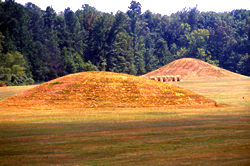Pharr Mounds
Pharr Mounds | |
 Two mounds at the Pharr Mounds site | |
| Nearest city | Tupelo, Mississippi |
|---|---|
| Coordinates | 34°27′59.3562″N 88°25′0.1734″W / 34.466487833°N 88.416714833°W |
| NRHP reference No. | 78000346[1] |
| Added to NRHP | February 23, 1978[1] |
Pharr Mounds is a Middle Woodland period archaeological site located near Tupelo in parts of Itawamba and Prentiss counties in northern Mississippi. This complex was made of earthwork mounds.
The complex of eight dome-shaped, tumulus burial mounds was in use during the Miller 1 phase of the Miller culture.[2] These were constructed as earthwork mounds between 1 and 200 CE. The complex is considered to be one of the largest and most important sites from this era.[3] It was listed on the National Register of Historic Places in 1978 as part of the Natchez Trace Parkway at milepost 286.7.[1]
Site description
The site is located at the headwaters of the Tombigbee River, a rugged, hilly area with many broad, swampy streams. It is named for "Pharr Flats", a wide, gently rolling terrace overlooking the confluence of Little Brown and Mackeys creeks. The site features eight dome-shaped mounds of differing sizes, several of which have been nearly flattened by plowing and cultivation during European-American farming. The mounds in the Pharr Mounds site are found over an area of 90 acres of land.[4]
| Mound | Width and length | Height |
|---|---|---|
| Mound A | 55 feet (17 m) by 65 feet (20 m) | 7 feet (2.1 m) |
| Mound B | 105 feet (32 m) by 110 feet (34 m) | 18 feet (5.5 m) |
| Mound C | 115 feet (35 m) in diameter | 18 feet (5.5 m) |
| Mound D | 80 feet (24 m) by 95 feet (29 m) | 12 feet (3.7 m) |
| Mound E | 165 feet (50 m) by 175 feet (53 m) | 8 feet (2.4 m) |
| Mound F | 60 feet (18 m) in diameter | 8 feet (2.4 m) |
| Mound G | 200 feet (61 m) in diameter | 6 feet (1.8 m) |
| Mound H | 110 feet (34 m) by 130 feet (40 m) | 2 feet (0.61 m) |

Archaeology
In 1966 Charles Bohannon, an archaeologist for the National Park Service, supervised[5] an excavation of four of the mounds. The excavators found fire pits and low clay platforms at the base of the mounds.[3] They also found human remains, some cremated, as well as various ceremonial artifacts.
Many of the artifacts were made from non-local materials, such as Great Lakes copper and greenstone, galena, and mica, demonstrating the reach of trading through the Hopewell exchange system. These artifacts, which include copper ear-spools and a greenstone platform pipe, show the connection of the local peoples with the larger Middle Woodland period world of the time, reaching to the Great Lakes.[3]
See also
References
- ^ a b c "National Register of Historic Places". National Register of Historic Places. National Park Service. 2010-11-16.
- ^ "Pharr Mounds-Ceramic analysis". National Park Service. Retrieved 2010-11-16.
- ^ a b c "Pharr Mounds-National Register of Historic Places Indian Mounds of Mississippi Travel Itinerary". National Park Service. Retrieved 2010-11-16.
- ^ a b "Pharr Mounds-The site and its setting". National Park Service. Retrieved 2010-11-16.
- ^ Excavation at the Pharr Mounds, US Department of Interior. July, 1972
External links
- Archaeological sites in Mississippi
- Miller culture
- Mounds in Mississippi
- National Register of Historic Places in Itawamba County, Mississippi
- National Register of Historic Places in Prentiss County, Mississippi
- Protected areas of Itawamba County, Mississippi
- Protected areas of Mississippi
- Protected areas of Prentiss County, Mississippi



